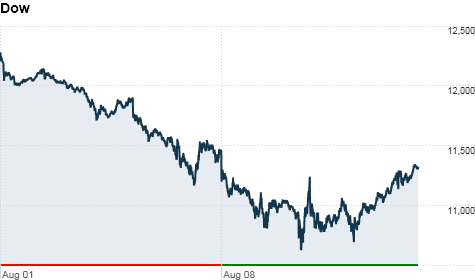
Traders said they've seen high-frequency trading volumes jump sharply since the beginning of the month, which may have ampilfied the recent volatility. Click the chart for more market data.
NEW YORK (CNNMoney) -- The computers have taken over Wall Street, and they're taking investors on a wild ride.
This week, the Dow swung back and forth more than 400 points on four straight days. Trading volume is at or near record levels.
It's not fast-talking traders on the New York Stock Exchange behind the action. The majority of trading is done on large server farms based in New Jersey and elsewhere.
"These types of moves are certainly greater than anything we've seen in the last 10 years, and it's absolutely because now the majority of the orders are being done by these high-frequency trading robots," said Sal Arnuk, co-founder of Themis Trading, an independent brokerage firm.
High-frequency trading, also known as algorithmic or programmed trading, relies on software to determine when to buy and sell shares, usually based on a particular pattern or technical level in the market. These trades can happen several times a minute.
High-frequency trading makes up 53% of all trading in U.S. stock markets, up from 21% in 2005, said Larry Tabb, president and CEO of market research firm Tabb Group. Other estimates put it even higher, at around 65%.
Gary Wedbush, executive vice president and head of capital markets at Wedbush Securities, told Bloomberg News on Friday that more than 80% of the firm's orders since Aug. 1 have come from high-frequency trading clients, at five times the typical volume.
Nearly everyone on Wall Street is involved in algorithmic trading in some form, Tabb said, including large banks, hedge funds and mutual funds.
"These firms often piggyback on large orders, so it can amplify a stock's movement," Arnuk said.
Experts don't blame high-frequency trading entirely for the market's nauseating moves, but they say it certainly exacerbates them.
The Securities and Exchange Commission in a report blamed high-frequency trading in part for the May 6, 2010 "flash crash," when the Dow fell nearly 1,000 points in minutes. ![]()
| Index | Last | Change | % Change |
|---|---|---|---|
| Dow | 32,627.97 | -234.33 | -0.71% |
| Nasdaq | 13,215.24 | 99.07 | 0.76% |
| S&P 500 | 3,913.10 | -2.36 | -0.06% |
| Treasuries | 1.73 | 0.00 | 0.12% |
| Company | Price | Change | % Change |
|---|---|---|---|
| Ford Motor Co | 8.29 | 0.05 | 0.61% |
| Advanced Micro Devic... | 54.59 | 0.70 | 1.30% |
| Cisco Systems Inc | 47.49 | -2.44 | -4.89% |
| General Electric Co | 13.00 | -0.16 | -1.22% |
| Kraft Heinz Co | 27.84 | -2.20 | -7.32% |
| Overnight Avg Rate | Latest | Change | Last Week |
|---|---|---|---|
| 30 yr fixed | 3.80% | 3.88% | |
| 15 yr fixed | 3.20% | 3.23% | |
| 5/1 ARM | 3.84% | 3.88% | |
| 30 yr refi | 3.82% | 3.93% | |
| 15 yr refi | 3.20% | 3.23% |
Today's featured rates: